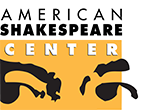Hello everyone! Liz here to start off the morning with the Wake-Up Workshop on Audience Contact! Live-blogging of this session will last from eight to eight forty-five in the morning. Natalia “Lia” Razak Wallace, ASC Education Artist, Mary Baldwin College Master of Fine Arts candidate, and Sweet Wag Shakespeare member, leads this session.
Wallace asks if everyone saw at least one show in the Blackfriars Playhouse. “We really like the audience,” she smiles. She talks about the space informing the performance – including the lights that stay on during the show, the audience surrounding the actors on three sides. She expresses her dislike of messy audience contact, which she calls “the wash”, and states that this dislike led to her thesis on eye contact with the audience. Wallace states that the best way to contact the audience is to face them.
Wallace then transitions and gives different categories for audience contact in early modern drama. She brings up a scholar to perform a scene from The Merchant of Venice to display the first form of audience contact – casting the audience. She and the scholar perform the scene between Portia and Nerissa from II.i. in a proscenium-style, directly on the same plane and facing each other on the stage. Now, Wallace gives the scholar some whispered directions and performs the scene again. This time, she and the scholar point to scholars in the audience, naming them as the suitors mentioned in the scene. The audience laugh more and accurately portray their parts this time around, due to the actors’ engagements with them. “Mocking people in reality is way more fun than mocking abstractions,” Wallace states to explain why making contact with individual audience members in this scene makes it so much stronger. Due to the continuous action and lack of lighting and stage changes at the top of a show on the early modern stage, casting the audience in early scenes commonly occurs to help bring the audiences into the world of the play. The audience cannot be cast the audience as any characters that appear in the play. Wallace states that everyone has one or two reactions to audience contact, which is either positive or negative.
Wallace calls the second allying. Humans are naturally convincing, so we want people to be on our sides. She mentions that Iago is one of her favorite characters because he spends so much time explaining himself to the audience. The audience will give support to characters that ask for audience support, which occurs with many different characters across many different plays. Wallace then grabs another audience member and has them read some lines from Richard III from the end of I.ii. She explains that this is a great example of character allying. Richard loves to share and the text wants to be shared, so the text begs for the actor to ally with the audience in this moment to convey why he is correct. Wallace says that states of emotion are contagious and that when we see someone do any action, our neurocortex actually has a part of us do that action as well. An audience member asks about Ben Curns’ interpretation of Richard as seduced by convincing others and explaining his handiwork to the audience.
The third form of audience contact is asking the audience a question or to seek information. Wallace gives an example of Polonius in the ASC’s Hamlet, where Polonius took the question, “What was I about to say?” to an audience member. Many audience members thought that the actor went up on his line, when he was really including them in the world of the play.
Wallace briefly explains the difference between audience contact and audience connection. Audience contact is an action that can be practiced without people in the room. This is in contrast to audience connection, which relies on the audience member’s reaction to the contact that occurs.
The fourth form of audience contact is using the audience as the object. This makes the audience an example, rather than a specific character. She exemplifies this through the discovery of an audience member with a drink in their hand and generalizing them as like “all drunk men.”
Wallace then has everyone look at a scene from Henry VI, Part I. She then asks for her two volunteers to play Suffolk and Margaret for the scene. She then states that the fifth form of contact is talking to your scene partner, because relationship between characters must be established before contact with the audience can be meaningful. Wallace reminds the group that there was no verisimilitude on the Elizabethan stage. She points out the odd nature of Margaret standing onstage silent for several minutes while Suffolk confides in the audience. Wallace specifically points to the Margaret line, “Why speakst thou not?” as evidence for audience contact on the Elizabethan stage. Suffolk talked for a while and the audience is aware of this, because they are privy to it. Yet Margaret’s line indicates that she has not heard any of these words. This evidences that the audience was Suffolk’s point of contact during the scene. Wallace quickly wraps up the workshop by wondering how the Margaret/Suffolk scene could work without audience contact.

